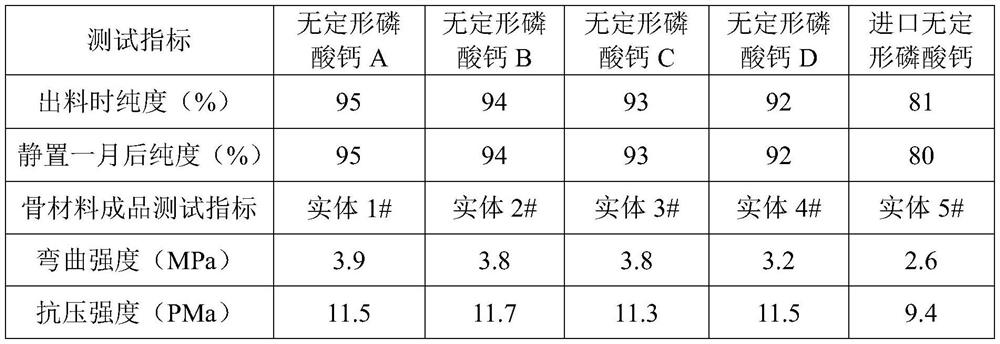A preparation method of high-performance biomedical amorphous calcium phosphate 3D printing material
An amorphous calcium phosphate, biomedical technology, applied in chemical instruments and methods, inorganic chemistry, additive processing, etc., can solve the problems of low purity, impossibility of application, and containing many impurities, and achieve excellent mechanical and mechanical properties.
- Summary
- Abstract
- Description
- Claims
- Application Information
AI Technical Summary
Problems solved by technology
Method used
Image
Examples
Embodiment 1
[0023] Preparation of amorphous calcium phosphate 3D printing material, prepared from the following parts by mass of raw materials according to the following steps:
[0024] a, 1 part of Ce(NO 3 ) 3 , 10 parts of magnesium chloride, 10 parts of aluminum chloride are added to 500 parts of pure water and fully stirred evenly, then 1 part of sodium fluoride and 10 parts of silica sol (SiO 2 The colloid concentration is 20%), stir and heat up to 150°C and keep it warm for 2 hours, stop the reaction and discharge, filter the reaction solution and fully wash, and then fully dry the filter cake at 80°C to obtain zero-charged magnesium silicate aluminum additives;
[0025] b. After mixing calcium chloride and calcium hydrogen phosphate dihydrate according to the molar ratio of Ca:P=3:2, then add the zero-charge magnesium aluminum silicate additive prepared in step a (the amount is calcium-containing substance and phosphorus-containing substance 0.01% of the total mass) and 500 part...
Embodiment 2
[0027] Preparation of amorphous calcium phosphate 3D printing material, prepared from the following parts by mass of raw materials according to the following steps:
[0028] a. Add 2 copies of Ce 2 (SO 4 ) 3 , 3 copies of Dy(NO 3 ) 3 , 15 parts of magnesium sulfate, 15 parts of magnesium nitrate, 20 parts of aluminum sulfate, and 10 parts of aluminum nitrate were added to 500 parts of pure water and stirred well, then 2.5 parts of lithium fluoride, 2.5 parts of sodium fluorosilicate, and 18 parts of silicon Sol (SiO 2 Colloid concentration is 22%), 12 parts of silica sol (SiO 2 The colloid concentration is 25%), stir and heat up to 200°C and keep it warm for 4 hours; stop the reaction and discharge, filter the reaction solution and fully wash, and then fully dry the filter cake at 95°C to obtain zero-charged magnesium silicate aluminum additives;
[0029] b. After mixing calcium nitrate, anhydrous calcium hydrogen phosphate, calcium dihydrogen phosphate, and sodium trip...
Embodiment 3
[0031] Preparation of amorphous calcium phosphate 3D printing material, prepared from the following parts by mass of raw materials according to the following steps:
[0032] a. Mix 1 part of CeCl 3 , 1 Dy 2 (SO 4 ) 3 , 0.5 parts of DyCl 3, 5 parts of magnesium chloride, 5 parts of magnesium sulfate, 5 parts of magnesium nitrate, 5 parts of aluminum chloride, 5 parts of aluminum sulfate, and 5 parts of aluminum nitrate were added to 500 parts of pure water and fully stirred evenly, then added 1 part of sodium fluoride, 1 part lithium fluoride, 1 part sodium fluorosilicate, 5 parts silica sol (SiO 2 Colloid concentration is 20%), 5 parts of silica sol (SiO 2 Colloid concentration is 23%), 5 parts of silica sol (SiO 2 The colloid concentration is 24%), stir and heat up to 160°C and keep it warm for 3 hours, stop the reaction and discharge, filter the reaction solution and fully wash, then fully dry the filter cake at 85°C to obtain zero-charged magnesium silicate aluminum ...
PUM
 Login to View More
Login to View More Abstract
Description
Claims
Application Information
 Login to View More
Login to View More - R&D
- Intellectual Property
- Life Sciences
- Materials
- Tech Scout
- Unparalleled Data Quality
- Higher Quality Content
- 60% Fewer Hallucinations
Browse by: Latest US Patents, China's latest patents, Technical Efficacy Thesaurus, Application Domain, Technology Topic, Popular Technical Reports.
© 2025 PatSnap. All rights reserved.Legal|Privacy policy|Modern Slavery Act Transparency Statement|Sitemap|About US| Contact US: help@patsnap.com

